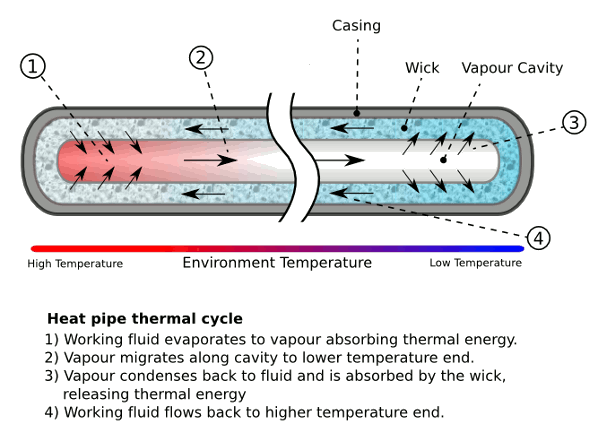| Tikalon Blog is now in archive mode.
An easily printed and saved version of this article, and a link
to a directory of all articles, can be found below: |
|
This article |
| Directory of all articles |
Pumping Water
August 10, 2010
One of the more interesting applications of basic physics is the
heat pipe, a passive device that uses the
surface tension effect between liquids and solids, also known as
capillarity, to transport heat. Chemistry can claim some of this fame, since the storage of heat is in the
latent heat of vaporization of the liquid. The liquid extracts heat by boiling, the vapors migrate to a part of the heat pipe that's below the boiling point, where they condense, and the liquid is drawn back to the hot zone via capillarity in a wicking material. Two common working fluids for heat pipes operating above room temperature are
ethanol (boiling point = 78.3
oC, heat of vaporization = 855 kJ/kg) and
water (boiling point = 100
oC, heat of vaporization = 2260 kJ/kg).

Heat pipe operating principle (Drawing by Maniago.
The
Cooling Technologies Research Center at
Purdue University is a cooperative program between the university and industry that's funded by the
National Science Foundation. The Center addresses pre-competitive research on heat removal from compact spaces, something that's becoming especially important for personal electronics and space-based electronic systems. Surprisingly, only a percent of electrical power in electronic systems does a useful function. The rest is converted into waste heat. One technology that this center is looking at is the use of
carbon nanofibers as a
thermally conducting medium, and as a wicking medium for heat pipes. In previous work[1], they used forests of nanotubes grown directly on chips to allow a more intimate thermal contact to heat-sinking media. The conductance of heat from the chips to the heat sinks was much greater than that through application of
thermal paste, something that's presently done.
Recently,[2] a Purdue team led by
Suresh V. Garimella is working on a
DARPA project that combines carbon nanotubes and small copper spheres as a wicking medium for water in heat pipes. One aspect of the heat pipe design is the ultrathin thermal plane of microchannels in contact with the chip. The boiling in these microchannels pushes the water through the system naturally so external pumps are not needed. Microchannel pores are created by copper coating 50-nm carbon nanotubes and then sintering the mass.
Such passive systems are nice, but there are many other ways to move coolant around in circuitry. Another Purdue publication[3] that I highly recommend reading lists the following
Mechanical Displacement |
Electro- and Magneto-kinetic |
- Diaphragm
- - Piezoelectric
- - Electrostatic
- - Electromagnetic/Magnetic
- - Thermal
- - Pneumatic
- - Composite / Polymer Materials
- - Irreversible
- - Peristaltic
- - Valves
- Fluid
- - Ferrofluid
- - Phase Change
- - Gas Boundary
- Rotary
- - Rotating Gear
- - Viscous Force
|
- Electrohydrodynamic
- - Induction
- - Injection
- - Polarization
- - Ion Drag
- Electroosmotic
- - DC
- - AC
- Magnetohydrodynamic
- Electrowetting
- Other
- - Optoelectrostatic Microvortex
- - Flexural Plate Wave
|
References:
- Joshua J. Romero, "Carbon Nanotubes Take the Heat Off Chips," IEEE Spectrum Online, December, 2007.
- Dexter Johnson, "Carbon Nanotubes Enable Pumpless Liquid Cooling System for Computers," IEEE Spectrum Online, July 29, 2010.
- B. D. Iverson and S. V. Garimella, "Recent Advances in Microscale Pumping Technologies: A Review and Evaluation," International Journal of Microfluidics and Nanofluidics, published online 19 February 2008 (DOI 10.1007/s10404-008-0266-8).
Permanent Link to this article
Linked Keywords: heat pipe; surface tension; capillarity; ethanol; water; Cooling Technologies Research Center; Purdue University; National Science Foundation; carbon nanofibers; thermal conductivity; thermal paste; Suresh V. Garimella; DARPA.